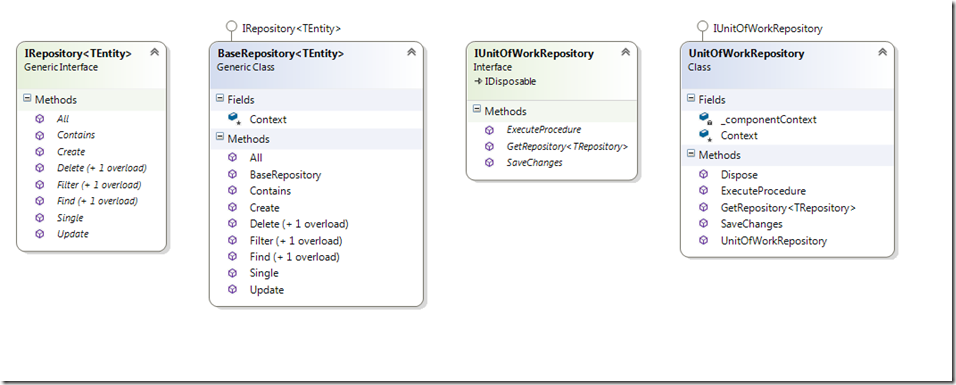关于Repository模式,在这篇文章中有介绍,Entity Framework返回IEnumerable还是IQueryable?
这篇文章介绍的是使用Entity Framework实现的Repositoy模式设计,欢迎各位拍砖.
阅读目录:
一、实现的思路和结构图
二、Repository设计具体的实现代码
三、Repository设计的具体的使用
四、总结
总结一下,Repository在实际使用中,有下面三种特点:
Repository的共同性
有一些公共的方法(增删改查), 这些方法无关于Repository操作的是哪个实体类,可以把这些方法定义成接口IRepository<TEntity>, 然后有个基类BaseRepository<TEntity>实现该接口的方法。
常见的方法,比如Find, Filter, Delete, Create等
Repository的差异性
每个Repository类又会有一些差异性,应当允许它们能够继承BaseRepository<TEntity>之外,还能够再扩展自己的一些方法。所以每个类都可以再定义一个自己特有的接口,定义一些属于自己Repository的方法。
Repository的协同性
不同的Repository可能需要协同,Repository对数据的修改,需要在统一的保存.
最终实现的类结构图如下:

IRepository<TEntity>接口定义了Repository共有的方法, BaseRepository<TEntity>实现了这些接口的方法。其它的Repository类再集成BaseRepository<TEntity>方法,就天然的得到了对数据操作的基本方法。
IRepository<TEntity>代码
public interface IRepository<TEntity> where TEntity : class { IQueryable<TEntity> All(); IQueryable<TEntity> Filter(Expression<Func<TEntity, bool>> predicate); IQueryable<TEntity> Filter(Expression<Func<TEntity, bool>> filter, out int total, int index = 0, int size = 50); bool Contains(Expression<Func<TEntity, bool>> predicate); TEntity Find(params object[] keys); TEntity Find(Expression<Func<TEntity, bool>> predicate); TEntity Create(TEntity t); int Delete(TEntity t); int Delete(Expression<Func<TEntity, bool>> predicate); int Update(TEntity t); TEntity Single(Expression<Func<TEntity, bool>> expression); }
BaseRepository<TEntity>代码
 logs_code_hide('049bcf6e-2ae6-4864-b548-8e7bd6d11a51',event)" src="/Upload/Images/2013090723/2B1B950FA3DF188F.gif" alt="" />
logs_code_hide('049bcf6e-2ae6-4864-b548-8e7bd6d11a51',event)" src="/Upload/Images/2013090723/2B1B950FA3DF188F.gif" alt="" />
public class BaseRepository<TEntity> : IRepository<TEntity> where TEntity : class { protected readonly DbContext Context; public BaseRepository(DbContext context) { Context = context; } public TEntity Single(Expression<Func<TEntity, bool>> expression) { return All().FirstOrDefault(expression); } public IQueryable<TEntity> All() { return Context.Set<TEntity>().AsQueryable(); } public virtual IQueryable<TEntity> Filter(Expression<Func<TEntity, bool>> predicate) { return Context.Set<TEntity>().Where<TEntity>(predicate).AsQueryable<TEntity>(); } public virtual IQueryable<TEntity> Filter(Expression<Func<TEntity, bool>> filter, out int total, int index = 0, int size = 50) { var skipCount = index * size; var resetSet = filter != null ? Context.Set<TEntity>().Where<TEntity>(filter).AsQueryable() : Context.Set<TEntity>().AsQueryable(); resetSet = skipCount == 0 ? resetSet.Take(size) : resetSet.Skip(skipCount).Take(size); total = resetSet.Count(); return resetSet.AsQueryable(); } public virtual TEntity Create(TEntity TObject) { var newEntry = Context.Set<TEntity>().Add(TObject); Context.SaveChanges(); return newEntry; } public virtual int Delete(TEntity TObject) { Context.Set<TEntity>().Remove(TObject); return Context.SaveChanges(); } public virtual int Update(TEntity TObject) { try { var entry = Context.Entry(TObject); Context.Set<TEntity>().Attach(TObject); entry.State = EntityState.Modified; return Context.SaveChanges(); } catch (OptimisticConcurrencyException ex) { throw ex; } } public virtual int Delete(Expression<Func<TEntity, bool>> predicate) { var objects = Filter(predicate); foreach (var obj in objects) Context.Set<TEntity>().Remove(obj); return Context.SaveChanges(); } public bool Contains(Expression<Func<TEntity, bool>> predicate) { return Context.Set<TEntity>().Count<TEntity>(predicate) > 0; } public virtual TEntity Find(params object[] keys) { return Context.Set<TEntity>().Find(keys); } public virtual TEntity Find(Expression<Func<TEntity, bool>> predicate) { return Context.Set<TEntity>().FirstOrDefault<TEntity>(predicate); } }View Code
IUnitOfWorkRepository接口定义了方法获取特定的Repository, 执行存储过程, SaveChange方法提交修改,统一更新数据。
IUnitOfWorkRepository接口代码:
public interface IUnitOfWorkRepository : IDisposable { TRepository GetRepository<TRepository>() where TRepository : class; void ExecuteProcedure(string procedureCommand, params object[] sqlParams); void SaveChanges(); }
UnitOfWorkRepository代码, 代码中使用到了Autofac中的IComponentContext来获取Repository实例
public class UnitOfWorkRepository : IUnitOfWorkRepository { private readonly IComponentContext _componentContext; protected readonly DbContext Context; public UnitOfWorkRepository(DbContext context, IComponentContext componentContext) { Context = context; _componentContext = componentContext; } public TRepository GetRepository<TRepository>() where TRepository : class { return _componentContext.Resolve<TRepository>(); } public void ExecuteProcedure(string procedureCommand, params object[] sqlParams) { Context.Database.ExecuteSqlCommand(procedureCommand, sqlParams); } public void SaveChanges() { Context.SaveChanges(); } public void Dispose() { if (Context != null) Context.Dispose(); } }
这里我们定义一个操作Student的Repository类,看看如何实际用于开发中。这里加入StudentRepository有自己特定的方法,需要获取所有的Students,这个扩展的方法名字叫GetAllStudents
那么定义一个接口IStudentRepository, 包含了方法GetAllStudents(), 同时继承IRepository<Student>接口
public interface IStudentRepository : IRepository<Student> { IEnumerable<dynamic> GetAllStudents(); }
然后定义StudentRepository类来实现这个接口
public class StudentRepository : BaseRepository<Student>, IStudentRepository { private readonly SchoolContext _context; public StudentRepository(SchoolContext context) : base(context) { _context = context; } public IEnumerable<dynamic> GetAllStudents() { return _context.Students; } }
使用Repository的代码如下:
IUnitOfWorkRepository unitOfWorkRepository = new UnitOfWorkRepository(); var studentRepository = unitOfWorkRepository.GetRepository<IStudentRepository>(); var students = studentRepository.GetAllStudents(); //同时你也可以使用定义于IRepository<Student>中的方法, 比如 //unitOfWorkRepository.Delete(students.First()); //unitOfWorkRepository.SaveChanges();
上面的设计,把Repository的通用代码剥离到父类中,同时又允许每个Repository扩展自己的方法,达到了比较理想的状态。
只是现在的设计和Autofac耦合了,但是想剥离Autofac的话,直接使用下面的方式获取IStudentRepository的实例就很困难。
unitOfWorkRepository.GetRepository<IStudentRepository>();
如果有什么好的办法,欢迎指教。也欢迎各位拍砖。
最后,附上本文的相关源代码. RepositoryDesign.zip